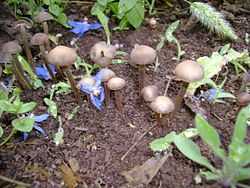Copelandia
| Copelandia | |
|---|---|
 | |
| Copelandia bispora | |
| Scientific classification | |
| Kingdom: | Fungi |
| Division: | Basidiomycota |
| Class: | Agaricomycetes |
| Order: | Agaricales |
| Family: | Bolbitiaceae |
| Genus: | Copelandia Bres. |
| Type species | |
| Copelandia papilionacea (Bull.) Bres. | |
Copelandia is a now deprecated [1] genus of mushrooms consisting of at least 12 species.[2] Many American mycologists previously placed members of Panaeolus which stain blue into Copelandia, whilst European mycologists generally used the name Panaeolus instead. Now all mushrooms previously categorised under the Copelandia genus are given the name Panaeolus universally.[1] The Copelandia genus was a subgenus of Panaeolus created by Abbé Giacomo Bresadola (1847–1929) in honor of Edwin Bingham Copeland (1873–1964), an American who gathered fungi in the Philippines and sent some collections to Bresadola.
Copelandia species are white to gray or tan, usually with long, thin fragile stem and are delicate. They are found in the tropics and neotropics of both hemispheres, growing in grasslands, on dead moss, dead grass, sand dunes, decayed wood, and dung. Blue staining on the caps and stems can often be observed where the mushroom has been bruised due to psilocin content. The cap is never viscid and often develops a cracked appearance as it dries out. None of the mushrooms in Copelandia have a partial veil and the gills always have thick walled pseudocystidia, often with crystals at the ends. Chrysocystidia are never present.
All species of Copelandia are known to contain the hallucinogens psilocin and psilocybin.
Species list
- C. affinis (E. Horak)
- C. bispora (Malençon & Bertault) Singer
- C. cambodginiensis (Ola'h & R. Heim) Singer
- C. chlorocystis Singer & R.A. Weeks
- C. cyanescens (Berkeley & Broome) Singer
- C. lentisporus (Ew. Gerhardt) Guzmán
- C. mexicana Guzmán
- C. tirunelveliensis Natarajan & Raman
- C. tropica Natarajan & Raman
- C. tropicalis (Ola'h) Singer & R.A. Weeks
See also
- List of Psilocybin mushrooms
References
- ↑ 1.0 1.1 Nathan Wilson & Herbert Baker. "Name: Copelandia affinis Horak". Mushroom Observer. Retrieved 2012-08-12.
- ↑ Rolf Singer
- Copelandia and other Psychoactive Mushrooms in Hawaii
- Dr. Rolf Singer
- Pollock. S. 1974. A novel experience with Panaeolus: A case study from Hawaii. Journal of Psychedelic Drugs vol. 6 (1 ): 85-89.
- Abbé Giacomo Bresadola (1847 - 1929)
- Taxonomische Revision der Gattungen Panaeolus und Panaeolina, by Ew. Gerhardt, 1996